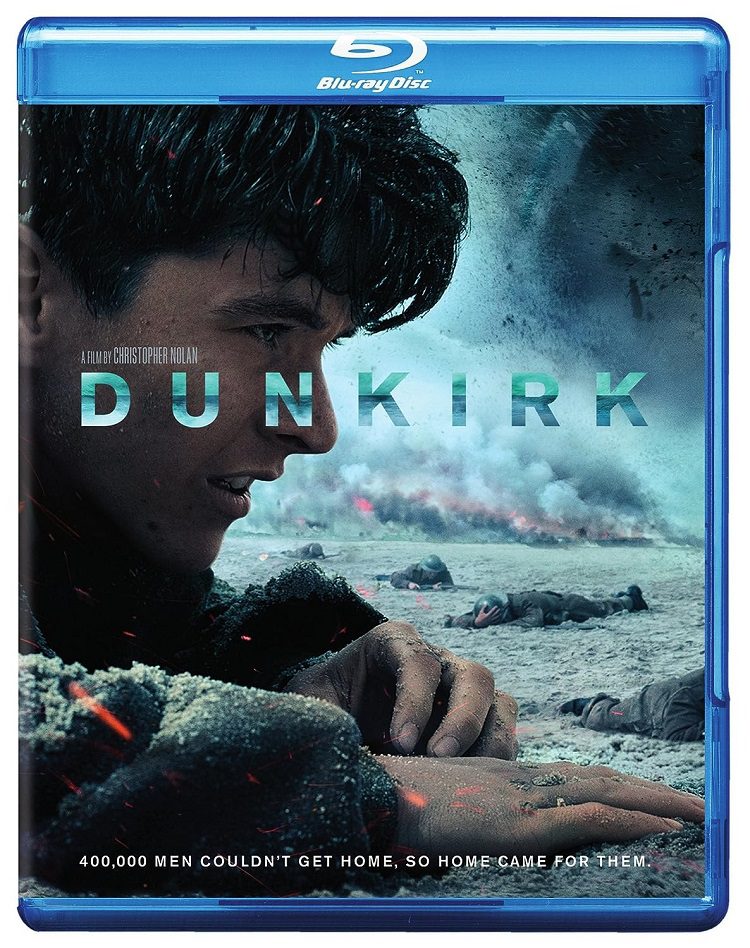
Christopher Nolan’s Dunkirk is an impressive World War II epic about the Allied military evacuation on the beaches of Dunkirk, France while under siege. The film weaves together three different narratives (on land, on sea, and in air) and delivers spectacular action sequences, but it’s the smaller moments of men exhibiting heroism and fear in the face of death all around when it is at its most captivating.
The Axis powers had “driven the British and French armies to the sea. Trapped at Dunkirk, they await their fate.” The film opens with six young soldiers walking deserted streets as Nazi propaganda falls from German planes while Hans Zimmer’s ethereal score plays. Shots rings out, soldiers are killed, a stopwatch ticks on the soundtrack as Tommy (Fionn Whitehead) runs to safety. He finds temporary respite on the beach with thousands of others waiting to evacuate, but then three German planes start dropping bombs.
With the enemy destroying their ships, the Royal Navy requisitions citizen’s boats to help transport the troops home. Mr. Dawson (Mark Rylance) sets off in his own. His son Peter (Tom Glynn-Carney) and Peter’s friend George (Barry Keoghan) join him. Along the way, they pick up a soldier (Cillian Murphy) on a capsized boat who is very upset about going back to Dunkirk. Three Royal Airforce pilots head to Dunkirk to provide cover. One, Farrier (Tom Hardy), loses his fuel tank gauge, making his mission more difficult. The three storylines intersect at various stages, and their convergence reveals a more accurate version of the story.
One great sequence has Tommy and a new friend find a body on a stretcher. Combining heroism to help a fellow soldier and self-preservation by using him to jump the evacuation line, they race across the beach. The way the violin strings are quickly drawn raises the tension. When the boat’s two-minute call is given, they run faster, not giving up hope. Bombs go off around them as they squeeze through men on the bridges cheering them on. But some times hope isn’t enough, as they and many others learn throughout.
The video has been given a 1080p/AVC MPEG4 encoded transfer. The aspect ratio alternates between 2.20 and 1.78, the latter for the scenes shot in IMAX. The production design palette is primarily muted colors. The gray and blues of the sky look accurate, although the cuts don’t always match up because of the sunlight breaking through the cloud cover. The teals on the Dunkirk beach have been augmented more than I care for. The whites, such as seen on Dawson’s boat, are bright. Blacks are inky and help contribute to the video’s strong contrast. Very fine texture detail is on display. Focus is usually sharp, but can slip, like inside Farrier’s cockpit where the plane’s vibration likely affects camera.
The audio is DTS-HD Master Audio 5.1 track. The gunfire sounds authentic. Bullets whizz around and connect with power. Bombs explode with strong subwoofer support. Planes rattle the sound system hard and cause some distortion. The ambiance, particularly during the land sequences. helps create an immersive experience. Dialogue is typically clear, although in the cockpit and over the radio it’s slightly impeded by the engines.
The Special Features are on a second disc. There is an extensive making-of (HD, 109 min) that runs a few minutes longer than the film. It’s broken into five chapters: Creation (four parts), Land (three parts), Air (two parts), Sea (five parts), and the two-part Conclusion. Viewers get to see what went into the undertaking of this film, including meeting with the veterans that survived Dunkirk. There’s also a brief Coast Guard Promo (HD, 2 min).
Dunkirk is an outstanding war film that strikes a great balance between the inhumanity of the weaponry and the humanity of the individuals. In a refreshing change of pace, the film runs less than two hours, as opposed to many of the bloated blockbusters of the era. Although it can’t capture the enormity of a 70mm/IMAX presentation, the Blu-ray brings home a high quality high-def presentation.